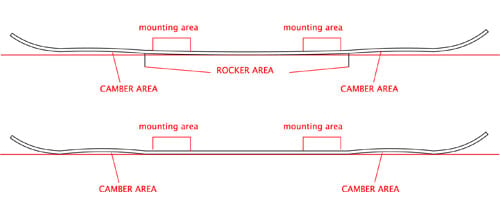Snowboard Running Length, R.I.P.
- Nov 18, 2010

Board sizing has always been a little tricky, but in the past, there have been a small group of readily available stats that have been very useful for comparison and selection by knowledgeable riders. One of those has been Running Length (AKA Contact Length).
As we have written many times, overall board length is a commonly considered, but almost useless measurement. Why? Because the shape and dimensions of a board's raised tip and tail can vary greatly and have next to no impact on the way the board will ride. These variations may change the overall board length by as much as 7 cm without having any significant effect on performance. I can feel some readers out there bristling to say, "but length effects spin weight and rotation". Sure, but in reality the difference in weight is negligible, and the difference you feel in spins is minor at best...and, most importantly for this article, tip to tip length will always be provided, so if it is important to you, it will always be available.
Most informed boarders have paid little to no attention to overall (tip to tip) length but have focused on Running Length as a major indicator of a board's true "size". This measurement was highly valued as it gauged the amount of board that would be in firm contact with the snow while riding. The running length was typically taken as a straight line measurement between the two contact points, which on traditional cambered boards pretty well corresponded with the board's wide points at both ends of it's effective edge. So, this really became a wide point to wide point measurement. Some manufacturers would measure this with the camber compressed (weighted) while others would take a non compressed measurement. In either case, the numbers were pretty close. Good retailers kept their own consistent internal measurements.

Enter Rocker. Rocker is an overused term that inaccurately groups about twenty different variations on Reverse Camber designs. One common element to all of the "Rocker" boards is that by design, the tip and tail, when weighted, are not in firm contact with the snow. Aside: For those readers who are about to comment that some designs are using additional cambered sections, etc, to re-achieve weighted wide point contact, please note that we do not consider these "true" Rockered designs. Although some of these do have a Rockered section (typically between the bindings) the end effect is a board with full contact at the tip and tail when weighted. End Aside.

So, how is running length being measured for Rockered boards? Well, that's interesting. For the mostpart, it's no longer being measured at all. Manufacturers that have been providing this measurement for years and in some cases decades, are now excluding the measurement from their literature and websites. Others have simply continued to measure wide point to widepoint, even while this is no longer a true representation of contact length.
Our suggestion: Two separate measurements. The fist being true weighted contact length and the second being the wide spot to wide spot measurement. This will allow the knowledgeable board seeker to get an idea of real running length, plus "available" running length (available by selective pressuring, even if not all at once) and wide spot distance to better gauge where the potential catch spots are in relation to rider stance.
But at least for now, Running Length, R.I.P.